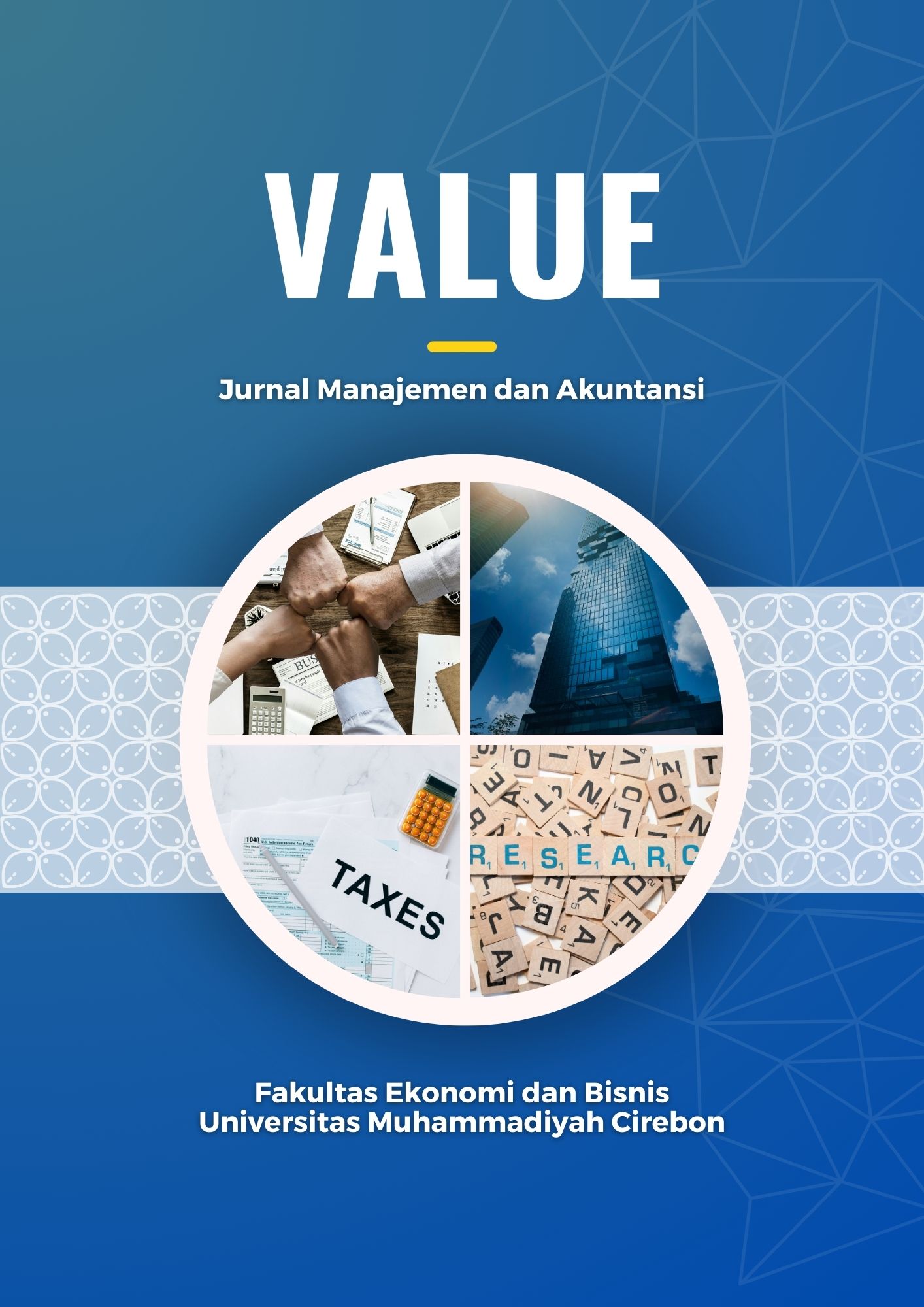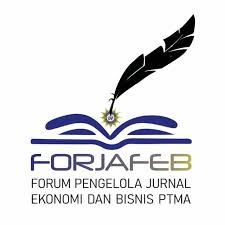Dari Biaya ke Kolaborasi: Investigasi Pengaruh Ganda Biaya Logistik dan Crowd Logistics terhadap Supply Chain Efficiency dalam Operasi Kurir Perkotaan
DOI:
https://doi.org/10.32534/jv.v20i2.7432Keywords:
Crowd LogEistics, Logistics Cost, Supply Chain Efficiency, Urban Courier, Last-Mile DeliveryAbstract
Urban courier services are increasingly compelled to enhance operational efficiency due to the escalating demand stemming from e-commerce growth and the complexities associated with last-mile delivery. This study investigates the influence of logistics costs and crowd logistics on supply chain efficiency within urban courier operations in the Bandung Metropolitan area. By addressing a notable empirical gap in the existing literature, this research additionally provides strategic insights into the advancement of participatory logistics in emerging economies. A quantitative methodology was employed, utilizing structured questionnaires distributed to employees of courier services, yielding 100 valid responses. The data were analyzed through the Partial Least Squares Structural Equation Modeling (PLS-SEM) technique. The findings reveal that both logistics costs and crowd logistics exert significant positive effects on supply chain efficiency. Notably, crowd logistics enhances delivery flexibility, minimizes idle capacity, and improves responsiveness to fluctuations in demand. This study contributes to the academic discourse by integrating cost-efficiency and participatory perspectives within the context of urban logistics. Practically, it offers valuable guidance for logistics providers and urban policymakers in the development of inclusive, adaptive, and sustainable delivery systems, aligning with the Sustainable Development Goals (SDGs).
References
Adnan, H. R., Hidayanto, A. N., & Kurnia, S. (2021). Citizens’ or government’s will? Exploration of why indonesia’s local governments adopt technologies for open government. Sustainability (Switzerland), 13(20). https://doi.org/10.3390/su132011197
Alharbi, A., Cantarelli, C., & Brint, A. (2022). Crowd Models for Last Mile Delivery in an Emerging Economy. Sustainability (Switzerland), 14(3). https://doi.org/10.3390/su14031401
Amin, H. M., & Shahwan, T. M. (2020). Logistics management requirements and logistics performance efficiency: The role of logistics management practices - Evidence from Egypt. International Journal of Logistics Systems and Management, 35(1). https://doi.org/10.1504/IJLSM.2020.103859
Andreji?, M., Paji?, V., & Stankovi?, A. (2023). Human Resource Dynamics in Urban Crowd Logistics: A Comprehensive Analysis. Journal of Urban Development and Management, 2(3). https://doi.org/10.56578/judm020303
Anggoro, Y., Rahmawati, D., Afgani, K. F., Afrianto, M. A., Permana, R., Andariesta, D. T., Kosasih, L. E., & Rahadi, R. A. (2022). Indonesian Logistics Preferences during COVID-19 Pandemic. International Journal of Finance, Economics and Business, 1(4). https://doi.org/10.56225/ijfeb.v1i4.56
Arsova, M., & Temjanovski, R. (2023). Logistics costs and their impact on performance. Journal of Economics, 8(1). https://doi.org/10.46763/joe2381055a
Banomyong, R., Grant, D. B., Varadejsatitwong, P., & Julagasigorn, P. (2022). Developing and validating a national logistics cost in Thailand. Transport Policy, 124. https://doi.org/10.1016/j.tranpol.2021.04.026
Beheshtinia, M. A., Feizollahy, P., & Fathi, M. (2021). Supply chain optimization considering sustainability aspects. Sustainability (Switzerland), 13(21). https://doi.org/10.3390/su132111873
Bin, H., Zhao, F., Xie, G., Huang, L., Wang, H., Zhu, R., & Jiang, L. (2020). Crowd-Sourcing a Way to Sustainable Urban Logistics: What Factors Influence Enterprises’ Willingness to Implement Crowd Logistics? IEEE Access, 8. https://doi.org/10.1109/ACCESS.2020.3044921
Bortolini, M., Calabrese, F., & Galizia, F. G. (2022). Crowd Logistics: A Survey of Successful Applications and Implementation Potential in Northern Italy. Sustainability (Switzerland), 14(24). https://doi.org/10.3390/su142416881
Ciepli?ska, J. R., & Szmelter-Jarosz, A. (2020). Toward most valuable city logistics initiatives: Crowd logistics solutions’ assessment model. Central European Management Journal, 28(2). https://doi.org/10.7206/cemj.2658-0845.21
Cui, K., Zhang, X., Zou, J., Huang, Y., & Rui, X. (2023). Enterprise Digitalization Enabling Supply Chain Development: Driving Mechanisms and Path Choices. Transactions on Economics, Business and Management Research, 3. https://doi.org/10.62051/vol3pp56-63
Feurich, M., Kourilova, J., Pelucha, M., & Kasabov, E. (2024). Bridging the urban-rural digital divide: taxonomy of the best practice and critical reflection of the EU countries’ approach. European Planning Studies, 32(3). https://doi.org/10.1080/09654313.2023.2186167
Forehand, K., Román, J., & Schaefer, T. (2021). Supply chain efficiency in the discount store industry post covid-19: Applying the supply chain efficiency ratio. Operations and Supply Chain Management, 14(4). https://doi.org/10.31387/oscm0470313
Gossa, J. S., Ngafidin, K. N. M., & Safitri, S. T. (2023). Analytic hierarchy process for evaluating the quality of courier services in e-commerce services from the perspective of Pos Indonesia Purwokerto. JURNAL INFOTEL, 15(3). https://doi.org/10.20895/infotel.v15i3.1016
Hair, J. F., Hult, G. T. M., Ringle, C. M., & Sarstedt, M. (2022). A primer on partial least squares structural equation modeling (PLS-SEM). In SAGE Publications, Inc. (Issue 1).
He, D., Jia, J., Wang, Y., You, L., Chen, Z., Li, J., Wu, Q., & Wang, Y. (2023). A Spatio-Temporal Hybrid Neural Network for Crowd Flow Prediction in Key Urban Areas. Electronics (Switzerland), 12(10). https://doi.org/10.3390/electronics12102255
Hsieh, C. C., Chen, S. L., & Huang, C. C. (2023). Investigating the Role of Supply Chain Environmental Risk in Shaping the Nexus of Supply Chain Agility, Resilience, and Performance. Sustainability (Switzerland), 15(20). https://doi.org/10.3390/su152015003
Huang, L., Xie, G., Blenkinsopp, J., Huang, R., & Bin, H. (2020). Crowdsourcing for sustainable urban logistics: Exploring the factors influencing crowd workers’ participative behavior. Sustainability (Switzerland), 12(8). https://doi.org/10.3390/SU12083091
Lichocik, G., & Sadowski, A. (2013). Eficiency of supply chain management. strategic and operational approach. LogForum, 9(2).
Liu, H., & Zhong, X. (2024). A hybrid evolutionary JAYA algorithm based on global optimization for 5G e-commerce logistics. Journal of Computational Methods in Sciences and Engineering, 24(1). https://doi.org/10.3233/JCM-237047
Liu, W., Liang, Y., Bao, X., Qin, J., & Lim, M. K. (2022). China’s logistics development trends in the post COVID-19 era. International Journal of Logistics Research and Applications, 25(6). https://doi.org/10.1080/13675567.2020.1837760
Lu, H., & Bao, J. (2022). Spatial Differentiation Effect of Rural Logistics in Urban Agglomerations in China Based on the Fuzzy Neural Network. Sustainability (Switzerland), 14(15). https://doi.org/10.3390/su14159268
Martín-Santamaría, R., López-Sánchez, A. D., Delgado-Jalón, M. L., & Manuel Colmenar, J. (2021). An efficient algorithm for crowd logistics optimization. Mathematics, 9(5). https://doi.org/10.3390/math9050509
Michel, S., Bootz, J. P., & Bessouat, J. (2023). Possible futures of crowd logistics for manufacturers: results of a strategic foresight study. Journal of Business and Industrial Marketing, 38(10). https://doi.org/10.1108/JBIM-12-2021-0548
Muha, R. (2019). An overview of the problematic issues in logistics cost management. Pomorstvo, 33(1). https://doi.org/10.31217/p.33.1.11
Muna, N., Ardini, L., & Inayah, Z. (2021). Lean Hospital: Strategy of Operational Financing Efficiency in Supply Chain Management. Jurnal Manajemen Kesehatan Indonesia, 9(1). https://doi.org/10.14710/jmki.9.1.2021.72-77
Nguyen, C. T., Yuen, K. F., Kim, T. Y., & Wang, X. (2024). An empirical research on the determinants of driver-partners’ participative behaviour in crowd logistics: from a motivation theory perspective. International Journal of Logistics Management, 35(2). https://doi.org/10.1108/IJLM-12-2022-0496
Prananingtyas, P., & Zulaekhah, S. (2021). The effect of logistics management, supply chain facilities and competitive storage costs on the use of warehouse financing of agricultural products. Uncertain Supply Chain Management, 9(2). https://doi.org/10.5267/j.uscm.2021.1.005
Prastyantoro, R., Purnomo, A., & Gunawan, A. (2024). Sustainable Supplier Selection Using AHP: A Green Purchasing Approach at PT Dapensi Trio Usaha. Dinasti International Journal of Management Science (DIJMS), 6(1), 1–9. https://doi.org/https://doi.org/10.38035/dijms.v6i1
Purnomo, A. (2024). Towards sustainable polio vaccine distribution: Evaluating a green metrics framework in Indonesia’s pharmaceutical industry. Decision Science Letters, 13, 741–750. https://doi.org/10.5267/dsl.2024.3.005
Queiroz, M. M., Fosso Wamba, S., Raut, R. D., & Pappas, I. O. (2024). Does Resilience Matter for Supply Chain Performance in Disruptive Crises with Scarce Resources? British Journal of Management, 35(2). https://doi.org/10.1111/1467-8551.12748
Rahmah, D. M., Fadhlurrahmah, J., Pujianto, T., Ardiansyah, I., & Mardawati, E. (2020). Measurement of Performance Efficiency of Kadatuan Koffie Suppliers Using Data Envelopment Analysis (DEA). Industria: Jurnal Teknologi Dan Manajemen Agroindustri, 9(1). https://doi.org/10.21776/ub.industria.2020.009.01.7
Rahman, S., Hossain, N. U. I., Moktadir, M. A., Mithun Ali, S., Katina, P. F., & Islam, M. S. (2022). A decision support model to assess organizational resilience in the textile industry. International Journal of Management Science and Engineering Management. https://doi.org/10.1080/17509653.2022.2157901
Rehman, O. ur, & Ali, Y. (2022). Enhancing healthcare supply chain resilience: decision-making in a fuzzy environment. International Journal of Logistics Management, 33(2). https://doi.org/10.1108/IJLM-01-2021-0004
Rezazadeh, H., & Tahmasebi, Z. (2021). Towards a deterministic sustainable cost-effective water supply chain. Uncertain Supply Chain Management, 9(3). https://doi.org/10.5267/j.uscm.2021.5.006
Rintala, O., Laari, S., Solakivi, T., Töyli, J., Nikulainen, R., & Ojala, L. (2022). Revisiting the relationship between environmental and financial performance: The moderating role of ambidexterity in logistics. International Journal of Production Economics, 248. https://doi.org/10.1016/j.ijpe.2022.108479
Saglietto, L. (2021). Bibliometric analysis of sharing economy logistics and crowd logistics. In International Journal of Crowd Science (Vol. 5, Issue 1). https://doi.org/10.1108/IJCS-07-2020-0014
Santoso, S., Nurhidayat, R., Mahmud, G., & Arijuddin, A. M. (2021). Measuring the Total Logistics Costs at the Macro Level: A Study of Indonesia. Logistics, 5(4). https://doi.org/10.3390/logistics5040068
Sari, M., Rachman, H., Juli Astuti, N., Win Afgani, M., & Abdullah Siroj, R. (2022). Explanatory Survey dalam Metode Penelitian Deskriptif Kuantitatif. Jurnal Pendidikan Sains Dan Komputer, 3(01). https://doi.org/10.47709/jpsk.v3i01.1953
Schianchi, M. (2023). IoT-based framework for agile supply chain in FMCG indus-tries – a solution for (post-)pandemic times. International Journal of Innovation in Engineering, 3(1). https://doi.org/10.59615/ijie.3.1.63
Siegfried, P., & Zhang, J. J. (2021). Developing a Sustainable Concept for Urban Last-Mile Delivery. Open Journal of Business and Management, 09(01). https://doi.org/10.4236/ojbm.2021.91015
Singh, S. K., Mittal, S., Sengupta, A., & Pradhan, R. K. (2019). A dual-pathway model of knowledge exchange: linking human and psychosocial capital with prosocial knowledge effectiveness. Journal of Knowledge Management, 23(5). https://doi.org/10.1108/JKM-08-2018-0504
?i?man, G. (2023). Implementing Lean Six Sigma methodology to reduce the logistics cost: a case study in Turkey. International Journal of Lean Six Sigma, 14(3). https://doi.org/10.1108/IJLSS-02-2022-0054
slam, Md. R. I., Monjur, Md. E. I., & Akon, T. (2023). Supply Chain Management and Logistics: How Important Interconnection Is for Business Success. Open Journal of Business and Management, 11(05). https://doi.org/10.4236/ojbm.2023.115139
Subiyanto, E. (2020). Investigating the logistics costs model: recent update in Indonesia. In Journal of Science and Technology Policy Management (Vol. 12, Issue 2). https://doi.org/10.1108/JSTPM-03-2020-0034
Sun, X., Yu, H., & Solvang, W. D. (2022). Towards the smart and sustainable transformation of Reverse Logistics 4.0: a conceptualization and research agenda. In Environmental Science and Pollution Research (Vol. 29, Issue 46). https://doi.org/10.1007/s11356-022-22473-3
Syafrianita, S., Purnomo, A., & Nasrudin, M. F. (2025). Investigasi Hubungan Antara Advanced Technology, Logistics Service Cost, Dan Logistics Performance di Shopee Express Bandung Raya. Land Journal, 6(1), 253–265. https://doi.org/https://doi.org/10.47491/landjournal.v6i1.4038
Tadi?, S., & Veljovi?, M. (2020). Logistics flows of household. Tehnika, 75(2). https://doi.org/10.5937/tehnika2002225t
Tan, Q. (2023). Research on the Application of Management Accounting in Logistics Enterprises in the Internet+ Era. Journal of World Economy, 2(3). https://doi.org/10.56397/jwe.2023.09.07
Wan, F. (2023). Analysis of the Impact of Human Resource Optimization on Supply Chain Efficiency Based on Performance Management. Journal of Global Humanities and Social Sciences, 4(6). https://doi.org/10.61360/bonighss232015370610
Wang, M., & Wang, B. (Bill). (2024). Supply chain agility as the antecedent to firm sustainability in the post COVID-19. International Journal of Logistics Management, 35(1). https://doi.org/10.1108/IJLM-02-2022-0059
Wang, W., & Xie, L. (2021). Coordinating Demand and Supply for Crowd Logistics Platforms with Network Effect. Mathematical Problems in Engineering, 2021. https://doi.org/10.1155/2021/1567278
Wu, D., & Cheng, J. (2022). Dynamic Pricing and Logistics Service Decisions for Crowd Logistics Platforms with Social Delivery Capacity. Mathematical Problems in Engineering, 2022. https://doi.org/10.1155/2022/5018145
Wu, J. (2022). Sustainable development of green reverse logistics based on blockchain. In Energy Reports (Vol. 8). https://doi.org/10.1016/j.egyr.2022.08.219
Yang, Y., Jiang, J., Wang, R., Xu, G., & Gu, J. (2023). Study on the Application of Activity-Based Costing in Cold Chain Logistics Enterprises under Low Carbon Environment. Sustainability (Switzerland), 15(18). https://doi.org/10.3390/su151813808
Yao, C. (2020). Research on logistics distribution path analysis based on artificial intelligence algorithms. International Journal of Biometrics, 12(1). https://doi.org/10.1504/IJBM.2020.105625
Yaqub, M. Z. (2023). The Role of Green Initiatives, Digitalisation and Procedural Justice in Maturing Supply Chain Agility. Open Journal of Business and Management, 11(02). https://doi.org/10.4236/ojbm.2023.112043
Zalia, A.-H., Zhang, Y., Aishatu, A., Akosua, A. S., & Fathia, B. V. (2021). Crowd Logistics’ Impact on Environmental Sustainability in a Developing Economy: An Analysis in Ghana. American Journal of Industrial and Business Management, 11(05). https://doi.org/10.4236/ajibm.2021.115027
Zheng, M. L., Ji, L. G., Huang, S. S., Zhang, L., & Lyu, C. (2022). The High-Quality Development Path of Grain Logistics in China in the New Era. Science and Technology of Cereals, Oils and Foods, 30(4). https://doi.org/10.16210/j.cnki.1007-7561.2022.04.001
Zhu, L. (2020). Optimization and Simulation for E-Commerce Supply Chain in the Internet of Things Environment. Complexity, 2020. https://doi.org/10.1155/2020/8821128
Zhu, X., Cai, L., Lai, P. L., Wang, X., & Ma, F. (2023). Evolution, Challenges, and Opportunities of Transportation Methods in the Last-Mile Delivery Process. Systems, 11(10). https://doi.org/10.3390/systems11100509


















